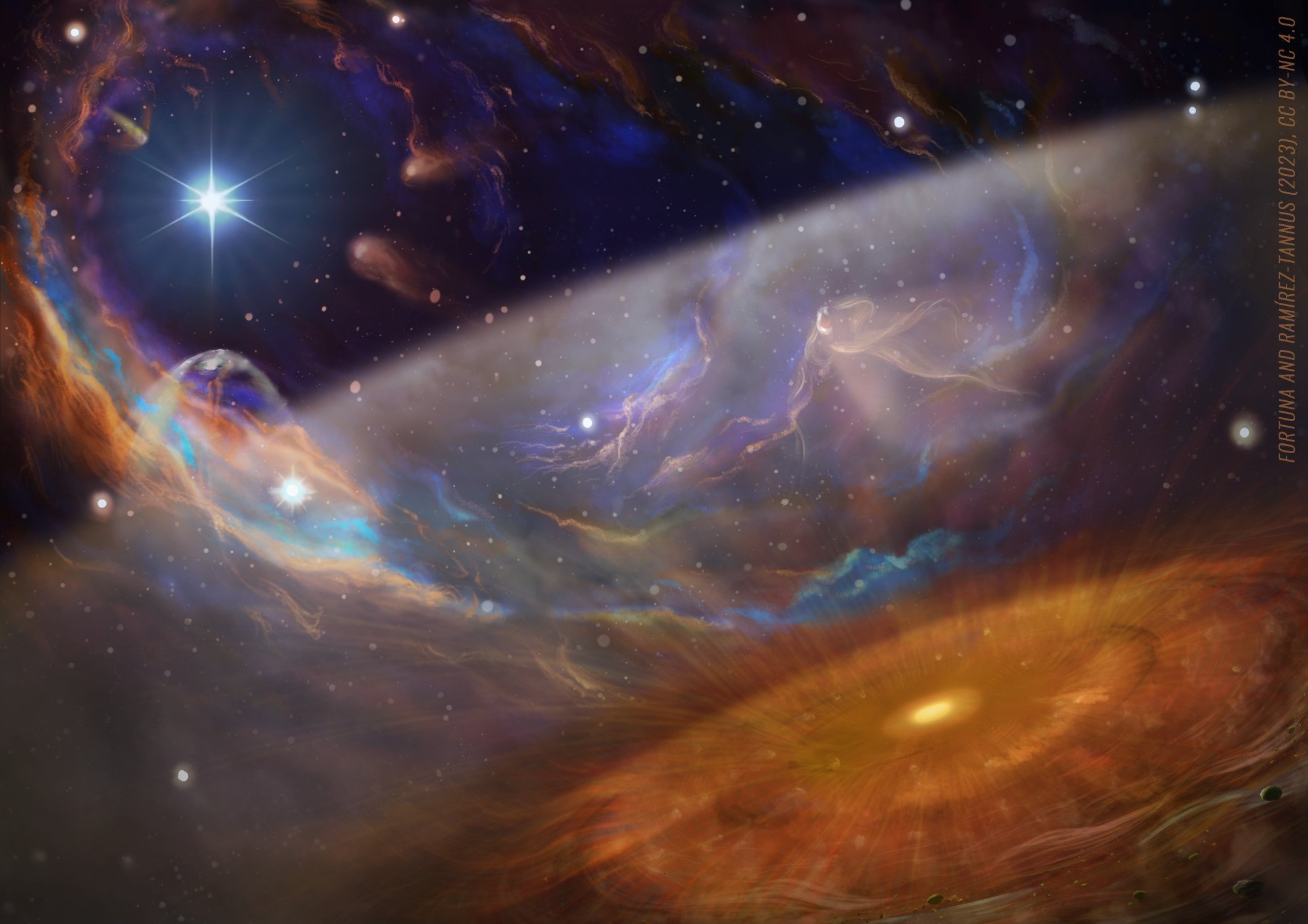In a groundbreaking discovery, astronomers using the James Webb Space Telescope have found that planets resembling Earth, complete with water, can form in the most unlikely places: regions of space with extreme conditions, drenched in harsh ultraviolet radiation from massive stars.
An artist's impression of a dense star-forming region with the planet-forming disk XUE1 in the foreground, bathed in UV light from massive stars, including one visible in the top left. The nearby structure shows the molecules and dust discovered in recent observations. - (Image Credit: Maria Cristina Fortuna)
The scientists focused their investigation on a young star similar to our Sun, surrounded by a disk of gas and dust, situated in one of the harshest environments of our galaxy. Using JWST's powerful MIRI instrument, they discovered essential elements for life as we know it: water and organic molecules.
The team named this unique disk XUE-1, which stands exposed to intense radiation from neighbouring colossal stars. Despite these extreme conditions, the disk showed promising signs for planet formation, including both water and simple organic molecules.
Lead researcher María C. Ramírez-Tannus from the Max Planck Institute expressed excitement at this surprising finding, highlighting its implications for understanding where and how Earth-like planets and life's ingredients can form.
A New Perspective on Massive Stars and Planet Formation
This study marks the first time scientists have made such detailed observations in regions dominated by massive stars. Unlike our relatively peaceful solar neighbourhood, these areas are bustling with the birth of numerous stars, including some very massive ones. Previously, it was thought that the intense radiation from these stars would make the formation of Earth-like planets rare. However, this new research challenges that assumption.
The team's work centred on NGC 6357, a nebula around 5500 light-years away, hosting more than ten high-mass stars. This environment provides a natural laboratory to study the effects of extreme radiation on planet formation. Surprisingly, they found that the conditions in at least one disk in this region are quite similar to those in more peaceful star-forming areas.
What Does This Mean for Finding Earth-Like Planets?
The discovery of water and other vital molecules in XUE-1 provides clues about the potential atmospheres of future planets formed in such environments. This finding suggests that even near massive stars, protoplanetary disks can foster the development of rocky, potentially habitable planets. The presence of silicate dust, a key component of rocky planets, further supports this possibility.
This research opens up exciting new avenues for understanding where Earth-like planets might be found. While it's still early to conclude the frequency of such planets in extreme environments, the team is enthusiastic about continuing their research. As co-author, Lars Cuijpers, a Radboud University master's student, notes, further investigations into more disks in the NGC 6357 region are planned as part of their ongoing JWST program.
This study not only expands our knowledge of where habitable planets might exist but also inspires awe at the resilience of planetary formation processes, even in the face of the universe's most daunting conditions.
This fascinating research was published in the peer-reviewed science journal Astrophysical Journal Letters. We have listed it below this article for those interested.
Sources and further reading:
Too busy to follow science news during the week? - Consider subscribing to our (free) newsletter - (Universal-Sci Weekly) - and get the 5 most interesting science articles of the week in your inbox
FEATURED ARTICLES:







